Ahh, those lovely and divisive double bass issues like standing–fodder for eternal and impassioned debate on both sides of the fence. Deciding whether or not to stand while playing the instrument (or to do both depending on the context) is a pivotal decision for every single bassist, and it is the source of much controversy and confusion.
Honestly, I should have my head examined for even considering tackling this thorny topic. I’m sure that even pointing out these various differences will cause a good deal of heated debate and disagreement (notice that I avoid mentioning the stance I actually use). What on Earth am I thinking? Who knows…but here it goes!
Double Bass – Non-Standardization at its Finest
Double bass is certainly one of the most non-standardized instruments in terms of size, shape, and pedagogical approach. While violins and cellos come in commonly accepted sizes, with specific measurement standards, the double bass family is truly all over the map. The very fact that our “standard” (whatever that word means in the bass world!) double bass size is referred to as a 3/4 size instrument has caused many an educator to throw up their hands in despair, and it only gets worse from there.
With non-standardized instrument sizes, string lengths, and instrument shapes, it’s no wonder that players and teachers have developed such a dizzying array of stances and postures to cope with this large instrument. But with such a bevy of options, what is the poor music educator to do? Throw a dart at a list of options and go with whichever they hit? Ask their local bass teacher (ask two or three teachers, and you’re likely to get two or three completely different responses)? How can students and teachers make an informed decision on such a slippery topic?
Why Stand? Why Sit?
Most bass players are taught to stand from an early age, and only sit on stools after several years on the instrument. Why?
Most professional orchestra players sit on stools, yet most jazz players stand. Why?
For most players, it is a combination of three factors:
- Tradition – what they were taught
- Instrument – how their instrument is shaped
- Context – what kind of playing they do
Interestingly, some double basses just really lend themselves to being played either sitting or standing. Some basses are constructed in such a way that touching the back with the leg (it’s almost impossible to avoid this in any sort of seated position) will mute the instrument quite noticeably. While I have actually seen a bassist with this kind of instrument build a sort of “chin-rest” to put space between his legs and the back (bassists will try anything!), many players with these easily mutable basses simply opt to stand.
Methods of Standing
There are at least a dozen distinct stances commonly used when playing the double bass in a standing position. Each of these methods have their proponents, some of which are convinced that their method is the “only method”, conveniently ignoring the multitude of successful players using an alternate method. As with every aspect of double bass playing, keeping an open mind and being receptive to various approaches allows a player to find the method (or combination of methods) that works best for their approach, size, and instrument.
Common standing stances
Here are a few of the most common approaches to playing the bass in a standing position:
(Fig. 1) Bass rear right corner balanced on hip – This classic stance accommodates a wide variety of double bass shapes and playing angles.
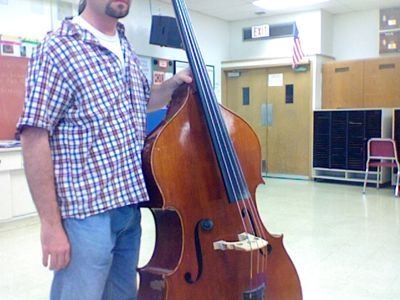
(Fig. 2) Bass balanced on belly – Commonly considered a bad habit, this stance is actually used by quite a number of double bassists. While keeping the instrument stable, this stance puts the player at a somewhat awkward angle for both left and right hand, and E string playing frequently bows into the player’s leg.

(Fig. 3) Bass in front of player but angled – This stance strikes a balance between the classic angled stance (Fig. 1) and the Rabbath stance (Fig. 4). A “turned out” bass stance puts the double bass more in line with the torso but necessitates more reaching in the right arm (highly controversial–see below).

(Fig. 4) “Rabbath” stance – Bass centered in front of player, with left hand parallel to spine and right arm plane parallel to bridge and body. A bent or angled endpin is often used in this stance.
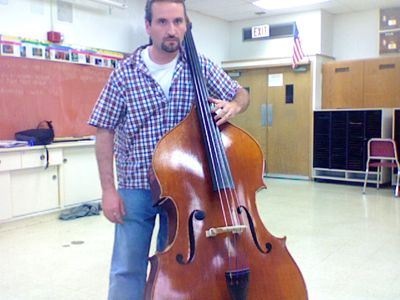
Methods of supporting the lower bout of the bass (standing)
(Fig. 5) Unsupported with leg – This is the most common method of standing with the double bass, regardless of what general standing stance is used. Both feet are in line with the torso, and may be positioned in a wider or narrower stance according to personal preference.

(Fig. 6) Supported by left leg – This stance provides a great deal of stability but throws the feet out of line with the torso. Holding the bass in a more upright position helps to facilitate this stance. This stance contrasts sharply with the “Rabbath” stance shown in Fig. 4. Using a bent endpin in this stance would not be a good idea!

(Fig. 7) Supported by left foot – Used most famously by Ludwig Streicher. I’m doing a rather poor imitation of this technique in this photo (I don’t use this technique!), but it gives you the general idea. Here’s a link a reader pointed out in the comments of a cartoon drawing of Streicher using the foot technique., and here’s a small photo of Streicher I found that shows this technique. Anyone have a better photo of this technique in use?

Seated postures
There are even more variations in seated double bass positions than there are for standing stances! Dozens of factors come into seated bass playing that don’t factor into standing when playing, including:
- stool height (high/low/medium)
- stool rung arrangement (high/low)
- stool design (wooden/metal; padded/hard; drum throne)
- use of foot stool (guitar foot stool, built-in footstool)
- endpin strap (Xeros strap, homemade strap)
- stool angle (flat/angled)
The list goes on and on, making seated postures a more complicated affair than the standing postures described above. Here are a few of the most common methods of sitting when playing the bass. Keep in mind that there are an infinite number of subtle variations within these basic postures, and that stool height, bass shape, and other factors influence one’s chosen posture.
( Fig. 8 ) Seated with pronounced bass angle – This is a classic seated position, with the right leg close to the middle of the lower rib and the left leg elevated (either on a stool rung or on a foot stool). This posture balances bow arm and left arm requirements quite well, and remains a popular method of holding the bass. One must take care not to bow into one’s right leg when in this position, especially when plying German bow!
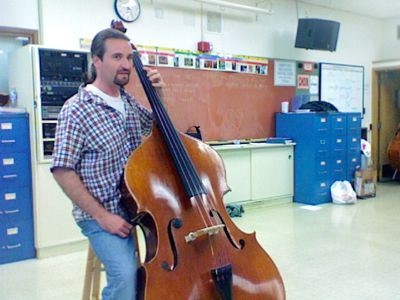
(Fig. 9) Seated with gentle bass angle (cello style) – This posture has become much more popular in recent years among both orchestra and solo bassists. Players with big upper bouts may find it easier to get into thumb position with this posture, and the alignment of the fingerboard with the vertical axis of the torso facilitates left hand technique for many players. Though this stance keeps the bow arm on a plane more in line with the player’s torso (helping with many bow fundamentals), many bassists find that the extra distance they have to reach in order to play on the G string causes unnecessary left shoulder strain and an uncomfortable torquing of the lower back. Narrower upper bouts often help with this. Players may either use a stool rung or foot stool for their left leg or else keep both feet flat on the floor in this stance.

(Fig. 10) Seated with high endpin – Endpin height is another hot topic among both standing and seated bassists. As mentioned in previous examples, instrument shape and player physiology often play as great a role in determining stance as any pedagogical dogma. In other words, if it works for you and your bass, do it! This posture brings the instrument table onto a more horizontal plane, which may be either advantageous or disadvantageous depending on one’s technical approach. This posture is often called “bazooka” bass playing.

(Fig. 11) Seated with low endpin – As with Fig. 10, this position involves a series of trade-offs, with a close resemblance to a standing posture in terms of instrument angle. Players often find playing in the low positions easier with this arrangement but may have difficulty keeping their bow close enough to the bridge and on a straight plane.
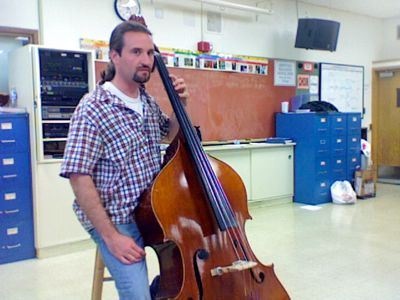
Which is the best stance for you?
Now here’s where I can get into a lot of trouble! Like arguing whether a Mac or PC is better (something that I’m actually doing in another series on this blog!), pointing out advantages of either method (or any of the sub-methods illustrated above) is likely to make fans happy and annoy detractors. I can’t resist putting out a few observations, though, so here it goes….
Advantages of Standing
- more natural posture for right arm
- body doesn’t mute instrument
- more body freedom
- ability to find the exact right position for every register of the bass
- right arm power more readily available
- easier to use large muscle groups when playing (this can be done in seated positions as well–it just takes more initial work)
Disadvantages of Standing
- more difficult to balance instrument
- easy to put a lot of tension on the left hand thumb
- can cause problems with tension (from trying to balance the bass)
- shifting significantly harder at first
- moving between neck and thumb positions more difficult
Advantages of Sitting
- less fatigue (who has to stand for hours at a time in rehearsal and performance?)
- easier for left hand to navigate bass
- shifting significantly easier
- bridging neck and thumb positions easier
- instrument more stable
Disadvantages of Sitting
- easy to slouch or develop poor posture
- body may mute the instrument
- less available right hand power (certain techniques can negate this tendency)
- upper left bout more likely to interfere with playing
- one becomes addicted to a particular stool and may not be able to play well without it
- one can easily lose the ability to play standing when sitting exclusively (what if you forget your stool?)
- have to carry a stool everywhere (even on flights – yay!)
Final Thoughts
How do you hold the bass? I wonder how many other instruments have opinions this heated and methods this divergent? Did you start standing and eventually start sitting, or vice-versa? Do you ever switch it up or alternate between these methods? Do you have any other methods of holding the instrument we didn’t cover here (I know there are a lot that I overlooked here!)?
Let me know! I’d love to hear your input. And if you have any photos showing how you hold the bass that you’d like included on the blog, send them along or post them in our Facebook Group.
Bass News Right To Your Inbox!
Subscribe to get our weekly newsletter covering the double bass world.

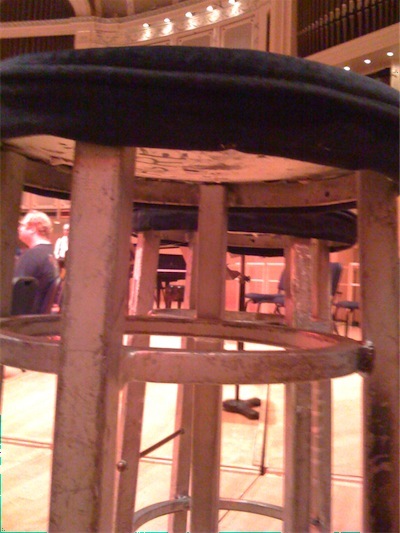
I posted a detailed follow-up here: http://www.sanbeiji.com/archives/866
But to summarize here – I think it is best to practice and be comfortable playing while standing because for the most part I think it is easier to switch to seated if you’re comfortable standing than it is to play comfortably standing if all you are used to is the seated positions.
I also posted a bit on my blog about some thoughts on the German vs. French bow factor in relation to sitting vs. standing. Just because we don’t have enough debate!
Great topic, Jason, and I hope you’re wearing your helmet and knee pads for the likely responses.
I’ve been going back and forth between sitting and standing for the past 25 years and I still haven’t found THE WAY that works best all the time. For jazz playing I usually feel more comfortable standing; if I’m playing a show under tight conditions and/or long duration I will most likely sit. Arco technique in general seems easier sitting but pizz feels better standing.
Most of the great jazzers of the past stood (tradition? I don’t know). But John Patitucci and Marc Johnson, for example, both sit. The terrific jazz/pop bassist Brian Bromberg stands when accompanying but sits down to solo…
Great post, Jason. My only issue is that your Streicher foot position is WAY off!
http://www.ludwig-streicher.at/site/bild_03.htm
This is the only photo illustrating the foot technique I could find.
Thanks for the link.
I have been mainly a standing player throughout my career, although I sat on one of my first steady gigs, five nights a week, 6 hours a night. That’s a lot of playing. I figured that standing would be too tough on feet and legs for that length of time, but I found that sitting could lead to back pain, legs “falling asleep” and a sore butt! I don’t think there are too many playing situations that are that grueling these days, but I think that switching between sitting and standing would be a good idea on a long gig.
The thing I like about standing is the fluidity possible in total body positioning (not just upper body as in sitting) which I think helps avoid fatigue and makes it easier for me to get around the instrument, but it sure is nice to get off your feet once in a while!
Good post. It would be cool to see some more detail about what each stance does to various bowing and fingering styles/techniques…. ; )
For that matter, why not a post about different styles of bow holds? There are at least 4 different ways of holding a french bow that are useful for different things… probably more. I know there are tons of different german grips out there. Here’s a website with some nice photos, although most of these grips are quite similar to each other, there are bound to be more options out there. (http://www.robertoppelt.com/page8.html)
-Trevor
What i’ve heard in relation to standing/sitting is that with solo performances, standing is a must. Then again, in orchestras, some require you to sit so that the orchestra is “level.” i would think that the best thing to do is to learn how to do both for the tons of different situations us bassists have to encounter
Bravo Jason-
There’s one more pretty distinctive stance, which I think of as the Milt Hinton stance.
It’s pretty much right in between Fig.1 and Fig.2, but the bass is standing straight up,
and I mean STRAIGHT up……balanced. You have to go a little more vertical with the left
hand, but the left hand is completely free to play, no support function at all is needed.
Here’s a good photo of what I mean. http://www.atlantajazzparty.com/vachcocuz.jpg
It’s good for obvious reasons…….there is NO trying to counterbalance the bass because
it is held in the position where it is perfectly balanced…..straight vertical.
As I’ve gotten older, I find myself doing it more and more, because it is less stressful
than any other stance. I hope some reasders find this useful.
Phil Flanigan
I usually stood when I was younger. But I started using a stool a few years ago for many gigs. But irregardless of whether I’m standing or seated, I find that I shift position fairly frequently to reduce fatigue rather than being in one position for extended periods.
I’m guilty of the ‘bass balanced on belly’ position. It seems to be an easy position for me to slip into from the ‘bass right rear corner balance on the hip’ stance. But I agree with Phil Flanigan’s comment about the straight up position he described as the ‘Milt Hinton’ stance. I use this stance a lot. I guess I started using it when I was younger because it also allows me to relax a little while playing steady for long periods. I also use the ‘supported by left leg’ position quite often along with a high endpin since I’m 6′ 2” and I like the instrument high, i.e. the nut is a few inches higher than eye level.
Jason, nice treatment of a varied topic. Thanks.
Lloyd Howard
thanks for the great post – sure helps with thinking about the issues.
another (possibly helpful) approach to the question would be to look at this with regards to the multiple forces at work while playing. in teaching guitar (MS/HS music and private lessons) i found that describing the forces involved helped students get a good understanding of why different positions work. a basic (left hand) idea is that the tiny thumb muscle isnt strong enough to support the pull of the fingers so a musician needs to adjust their position to find other counters to the force of the fingers. incidentally, this would be an advantage of sitting (counters the finger force).
in any event, seeing all of these positions sure helps so thanks!
Thanks for telling the disadvantages to playing sitting because I did not realize any, but being able to keep them in mind will definatly help my futher progression.
I started playing within the past year and I tried to play standing, but i found it harder for me to get the right fingerings, so I prefer being able to use a stool, but being able to play in both ways should be the ideal for a player; and I thought what you said was very helpful.
Check this youtube of Stanley Clark sitting. No problem with sitting!
http://www.youtube.com/watch?v=Py3jT0uaZw0
A technique for standing that works well for me is to have the bass at such an angle that, if at all, it falls forward. This relieves pressure on the left thumb and makes bowing the G string easy. Of course, the weight of the bow cannot be used then. I play french bow.
in the sixtys I worked with a well known multi-instrumentalist[who shall remain nameless]who always yelled at his bassists when they sat because he thought they were not digging in enough and kind of slacking on the job. that having been said generally speaking there is a certain energy from the angle of attack when you stand[jazz playing],and also it free’s up your body more so you can be more fluid and move with the music.
however I’m 66 now and with a few ailments one might expect of a man my age that make it tiring to stand for 2 hours. also I’ve been playing in a regional symphony and for me sitting stabilizes my
body much more securely than standing.
symphony
stan
pecpect
h
Good info.
The photos of the sitting positions should be full length for clarity.
I practice standing AND sitting because my 72 year old body tells me to.
I usually stand when playing jazz and sit for orchestra. Using a C extension can be rather challenging while standing. It adds a balance problem and makes it difficult to “hold” the bass while on the fingered low notes.